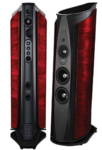It is a question which can be easily Googled and the answer given is 'bi-wiring'.
But there is difficulty getting a historical perspective to the 'why' question from certain speaker builders point of view. Which in my opinion is far more interesting. Because why is it that some builders choose for two terminals and others choose four. The ones which apply two say there is no need for four, and those are not the worst ones.
An explanation that I picked up is that Bi Wiring didn't seem to be a solution for anything in the early days, but 'Bi Amping' was. The reason was that despite the fact that good amps existed, they came with a big price tag. The average affordable amplifiers were not that well and so the 4 terminals on more powerful speakers were a solution so the woofer and treble of the speakers could be driven by two average amps or average amps that specifically did one of the two ranges best, acting together as one good amp of the likes we find nowadays.
Given that what qualifies as a cheap amp nowadays is a leap of a universe better than a cheap amp in let's say 1965- 1970.
Following up. The solutions of those days became a relic of the past and the 4 terminals remained as a signature at companies like B&W and Wharfedale as it also creates a premium look to it compared to speakers with two terminals. Function became marketing.
It seems plausible, but there seems no reference to it online. Also in general there is a gap in a historical perspective. Apart from a general history of loudspeakers and history for the purposes of branding, there is not really a background on historical choices per brand outside marketing. It is for example difficult to find insights from engineers in why they made particular choices. Where the computer world is totally open (every choice and mistake Apple made is in Herzfeld's blog) but the speaker world seems rather closed.
But there is difficulty getting a historical perspective to the 'why' question from certain speaker builders point of view. Which in my opinion is far more interesting. Because why is it that some builders choose for two terminals and others choose four. The ones which apply two say there is no need for four, and those are not the worst ones.
An explanation that I picked up is that Bi Wiring didn't seem to be a solution for anything in the early days, but 'Bi Amping' was. The reason was that despite the fact that good amps existed, they came with a big price tag. The average affordable amplifiers were not that well and so the 4 terminals on more powerful speakers were a solution so the woofer and treble of the speakers could be driven by two average amps or average amps that specifically did one of the two ranges best, acting together as one good amp of the likes we find nowadays.
Given that what qualifies as a cheap amp nowadays is a leap of a universe better than a cheap amp in let's say 1965- 1970.
Following up. The solutions of those days became a relic of the past and the 4 terminals remained as a signature at companies like B&W and Wharfedale as it also creates a premium look to it compared to speakers with two terminals. Function became marketing.
It seems plausible, but there seems no reference to it online. Also in general there is a gap in a historical perspective. Apart from a general history of loudspeakers and history for the purposes of branding, there is not really a background on historical choices per brand outside marketing. It is for example difficult to find insights from engineers in why they made particular choices. Where the computer world is totally open (every choice and mistake Apple made is in Herzfeld's blog) but the speaker world seems rather closed.


